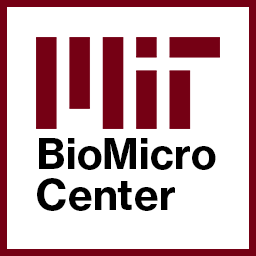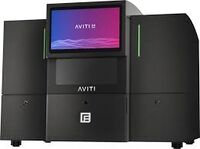BioMicroCenter:Element Sequencing
Element Sequencing[edit]
The Center currently hosts an AVITI24 platform from Element Biosciences. AVITI24 platform supports both sequencing and cytoprofiling. For most sequencing needs, the Center will use Element's Freestyle chemistry kits.
|
ANCHORS[edit]Element supports both Illumina anchors (P5/P7) using 'Freestyle' chemistry and and Element Anchors (SP5/SP27) for 'Adept' chemistry. For runs in the BMC, P5/P7 anchored library (Illumina) are preferred. Element Adept libraries (SP5/SP27) require a 5'-phosphate on the forward end in order to circularize and sequence. INDEXING[edit]Compared to an Illumina platform, AVITI24 reads are similar in read direction to Illumina's Forward Strand workflow for Dual Indexed Libraries. Indexes are read from antisense primers to the forward and reverse reads with the P7 side read first (index 1). Indexes are therefore antisense to the ordered oligos in traditional chemistry. Index sequences should be provided AS READ and not as ordered.
SINGLE LANE[edit]Each lane of the AVITI24 can be loaded independently. Flowcells require both lanes to be filled to be run. Custom primers must be designed to not interfere with other user's samples. All other requests require a full flowcell. 300PE kits only have a single lane. MINIMUM READS[edit]Minimum reads per lane are guaranteed if:
|
The AVITI24 Platform[edit]
The AVITI24 can run 2 flow cells per run, each hosting 2 independently-addressable lanes. Both lanes are washed with the same reagents. Element currently offers kits with 150 and 300 cycles, both supporting 2 lanes, as well as a 600 cycle kit that supports a single lane. Index hopping rates are similar to non-patterned Illumina, limiting the need for UDI's. The AVITI24 can also perform direct in sample sequencing which includes spatial imaging of RNA, proteins, phospho-proteins, and cell morphology using Teton chemistry for cytoprofiling.

